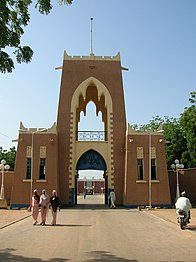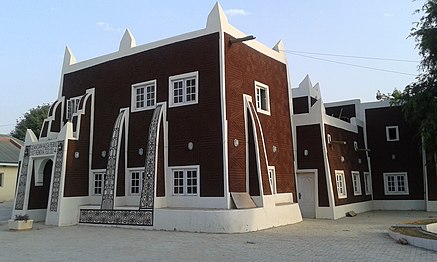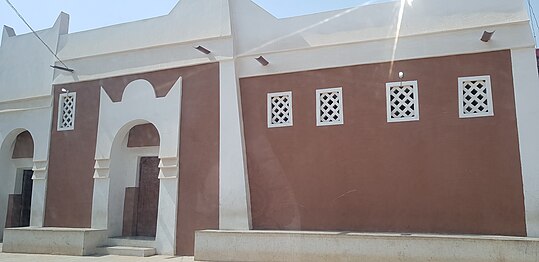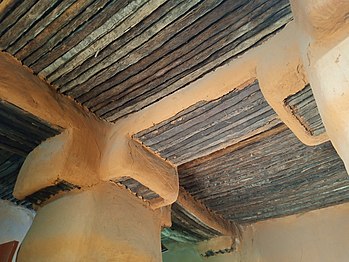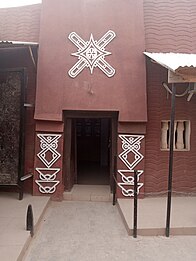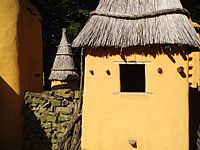Hausa architecture
This article provides insufficient context for those unfamiliar with the subject. (August 2019) |

Hausa architecture is the architecture of the Hausa people of Northern Nigeria and Niger.[1] Hausa architectural forms include mosques, walls, common compounds, and gates. Hausa traditional architecture is an integral part of how Hausa people construct a sense of interrelatedness with their physical environment.[citation needed] The architectural program used in this society is one disciplined by Islam and results in a highly organized spatial structure which is used to express features of Hausa culture.[2]
Environment
[edit]Geology
[edit]The main portion of the Hausaland consists of pre-Cambrian rocks, but turn into tertiary sediments in the east. The sites of early settlements were often located around inselbergs due to the minerals in these rocks. A large portion of the Hausaland is covered in laterite, which is the most important building material used in Hausa Architecture.[3]
Topography
[edit]
The topography of the Hausaland is suited for using horses for transportation. This has historically allowed for easy transportation of both people and products across the land.[4]
Climate
[edit]The northern portion of the Hausaland has a semi-arid climate while the southern portion is closer to savanna.[5]
Architecture
[edit]Building Types
[edit]Where Hausa Architecture differs from other architectural programs across the globe is its limited use of spaces for specialized activities. The main parts of a Hausa city are the defensive wall, the palace, mosques, the market, and domestic buildings. In Hausa buildings, there are three main elements: the primary room, the courtyard, and the wall. With these three components, many variations of buildings have been created for a multitude of uses.[6]
Domestic Architecture
[edit]It is common to see the traditional African pattern of rooms arranged around the courtyard in domestic buildings. The order of building operations follows closely to the pre-Islamic order with the perimeter wall being the most important.[7][8]
The Hausa Palace
[edit]
The Hausa Palace is essentially a larger version of the domestic buildings in Hausa Architecture. Palaces symbolized political power, community solidarity, and religious authority. Palaces are located at the city center, which predates Islamic influence.[9]
Mosques
[edit]Mosques in Hausaland typically consist of one room whose Qibla wall is denoted by a mihrab. The roof may be made of mud, thatch, or - as of recently - tin. The roof may also be accessible for prayer use. There is a typical use of either reinforced columns and support beams or reinforced support arches to help keep the building in place. The decoration is not typically a notable feature of these mosques. Instead, the use of large sculptural forms creates the feeling inside the space, and decoration is used mainly to emphasize the mihrab area. It is usually placed inside a rectangular walled courtyard, with the corners of the building lining up with North, East, South, and West.[10]
Construction
[edit]When first built, a Hausa building will have a crisp, clean, and efficient look that is a product of strict structural discipline. The organic forms for which Hausa Architecture is known results from the erosion process that comes with rain. Each dry season, the buildings are repaired to bring them back to that neat and clean look.[11]
Tubali
[edit]Tubali is the Hausa architectural style predominant in Northern Nigeria, Niger, eastern Burkina Faso, northern Benin, as well as some West African countries.[12]
Gallery
[edit]-
Gidan Rumfa in Kano
-
Kano Museum, an example of Hausa Tubali architecture
-
Hausa architectural painting and exterior design
-
Roofing style
-
Entrance known as Zaure
-
Simple pattern illustration in Walls
See also
[edit]- Sudano-Sahelian architecture
- Babban Gwani (legendary Hausa architect)
References
[edit]- ^ Umar, Gali Kabir; Yusuf, Danjuma Abdu; Ahmed, Abubakar; Usman, Abdullahi M. (2019-09-01). "The practice of Hausa traditional architecture: Towards conservation and restoration of spatial morphology and techniques". Scientific African. 5: e00142. doi:10.1016/j.sciaf.2019.e00142. ISSN 2468-2276.
- ^ Moughtin, J.C. (1985). Hausa Architecture. London: Ethnographica. p. 97. ISBN 0905788400.
- ^ Moughtin, J.C. Hausa Architecture. p. 7.
- ^ Moughtin, J.C. Hausa Architecture. pp. 7–8.
- ^ Moughtin, J.C. Hausa Architecture. p. 9.
- ^ Moughtin, J.C. Hausa Architecture. pp. 56–57.
- ^ Moughtin, J.C. Hausa Architecture. p. 57.
- ^ Moughtin, J.C. Hausa Architecture. p. 59.
- ^ Moughtin, J.C. Hausa Architecture. p. 74.
- ^ Moughtin, J.C. Hausa Architecture. pp. 84–86.
- ^ Moughtin, J.C. Hausa Architecture. p. 115.
- ^ "Hausa Architecture". www.afropedea.org. Archived from the original on 2020-09-19. Retrieved 2019-12-31.


